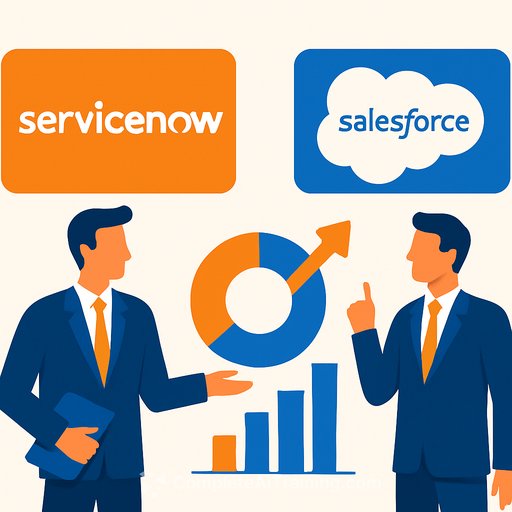CRM vs. NOW: Which Workflow Automation Stock Has More Upside?
ServiceNow (NOW) and Salesforce (CRM) lead the workflow automation market by helping businesses streamline operations with cloud-based software and AI tools. Enterprises rely on these platforms to boost efficiency and improve service delivery.
Salesforce focuses on front-office workflows like lead management, customer service, and campaign automation. ServiceNow primarily automates internal workflows such as IT service management, employee onboarding, and case resolution. As enterprise workflows grow more complex, the demand for automation is increasing.
According to a Mordor Intelligence report, the global workflow automation market is expected to grow from $23.77 billion in 2025 to $37.45 billion by 2030, at a 9.52% CAGR. Both CRM and NOW are positioned to benefit as AI-driven workflow platforms gain wider adoption.
The Case for ServiceNow
ServiceNow has seen strong growth as enterprises scale their digital operations. Its platform supports automation across IT, HR, finance, procurement, legal, and support, helping organizations improve efficiency and speed up value delivery.
Large deal momentum remains robust. ServiceNow closed 89 transactions with over $1 million in net new annual contract value (ACV), including 11 deals above $5 million. The number of customers contributing more than $5 million in ACV rose to 528 from 508 last quarter. Clients spending over $20 million grew 30% year over year, showing deeper enterprise commitment.
ServiceNow’s expanding portfolio is a key driver. The Core Business Suite, launched in May 2025, adds AI-native capabilities that connect workflows across departments, improving execution in procurement and legal. In July, ServiceNow introduced Agentic Workforce Management to enable supervised AI task execution across IT and operations. AI agents were also integrated into Security and Risk offerings through partnerships with Microsoft and Cisco to accelerate threat detection and automate incident response.
For Q3 2025, subscription revenues are projected between $3.26 billion and $3.265 billion, indicating 20%-20.5% year-over-year growth on a GAAP basis. On a constant currency basis, growth remains around 19.5%. The Zacks Consensus Estimate for Q3 subscription revenue stands at $3.26 billion, up 20.2% year over year, reflecting strong enterprise demand.
The Case for Salesforce
Salesforce continues to expand adoption of its platform by connecting sales, service, marketing, and analytics workflows under one system. Its Customer 360 architecture integrates core apps with real-time data and AI, enabling unified engagement and scalable operations.
Recent acquisitions like Informatica, Zoomin, and Own Company have enhanced Salesforce’s capabilities in data integration, content automation, and documentation intelligence. More than half of Salesforce’s top 100 deals in Q1 included six or more clouds, with nearly 60% featuring both Data Cloud and AI. This highlights strong demand for integrated applications with embedded intelligence.
Remaining performance obligations reached $29.6 billion, up 12% year over year, reflecting continued investment in multi-cloud deployments. Salesforce’s product portfolio supports AI agents across sales, service, and marketing, powered by Data Cloud for real-time data activation. Integrations with Snowflake, Databricks, Google BigQuery, and Amazon Redshift enable zero-copy data access and streamline AI workflows.
Salesforce forecasts Q2 sales between $10.11 billion and $10.16 billion, with Subscription and Support revenues expected to grow about 9.5% year over year, up from 8.5%. The Zacks Consensus Estimate for Q2 Subscription and Support revenue is $9.6 billion, a 9.6% increase. Remaining performance obligations are estimated at $59.84 billion, up 11.8% year over year. Salesforce remains well-placed to meet enterprise demand for unified AI platforms combining applications, automation, and data.
Price Performance and Valuation of NOW and CRM
Year-to-date, NOW shares have declined 12.5%, while CRM shares have fallen 24.2%. Valuation metrics suggest both are overvalued, with NOW assigned a Value Score of F and CRM a D. On a forward 12-month Price/Sales basis, NOW trades at 13.46X, significantly higher than CRM’s 5.74X.
How Do Earnings Estimates Compare for NOW & CRM?
- ServiceNow’s 2025 earnings estimate is $16.79 per share, up 1.51% over the past 30 days, representing a 20.62% year-over-year increase.
- Salesforce’s fiscal 2026 earnings estimate is $11.30 per share, unchanged in the last 30 days, indicating a 10.78% year-over-year rise.
Conclusion
Both ServiceNow and Salesforce are set to benefit from growing enterprise investment in AI-driven workflow automation despite economic challenges and tariff concerns. ServiceNow’s strong portfolio, acquisitions, and partnerships give it an advantage over Salesforce, which faces stiff competition and a tougher macro environment.
Currently, ServiceNow holds a Zacks Rank #3 (Hold) while Salesforce is ranked #4 (Sell), giving ServiceNow a slight edge for investors seeking exposure to workflow automation growth.
Your membership also unlocks:






